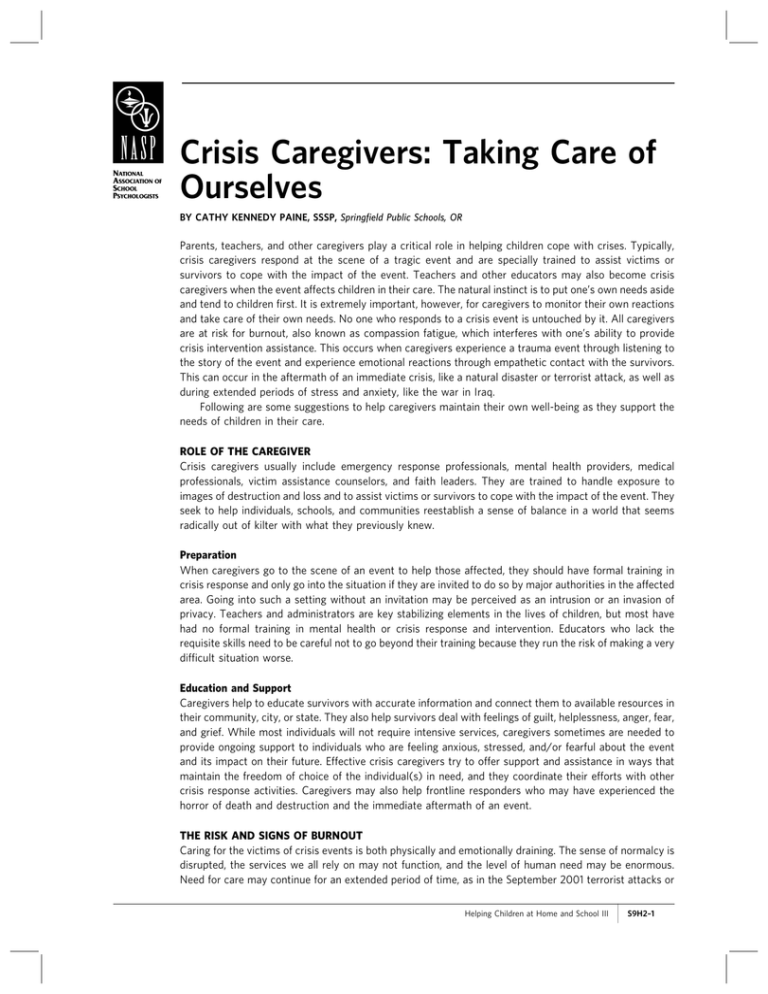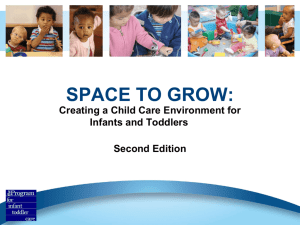Crisis Caregivers: Taking Care of Ourselves
advertisement

Crisis Caregivers: Taking Care of Ourselves BY CATHY KENNEDY PAINE, SSSP, Springfield Public Schools, OR Parents, teachers, and other caregivers play a critical role in helping children cope with crises. Typically, crisis caregivers respond at the scene of a tragic event and are specially trained to assist victims or survivors to cope with the impact of the event. Teachers and other educators may also become crisis caregivers when the event affects children in their care. The natural instinct is to put one’s own needs aside and tend to children first. It is extremely important, however, for caregivers to monitor their own reactions and take care of their own needs. No one who responds to a crisis event is untouched by it. All caregivers are at risk for burnout, also known as compassion fatigue, which interferes with one’s ability to provide crisis intervention assistance. This occurs when caregivers experience a trauma event through listening to the story of the event and experience emotional reactions through empathetic contact with the survivors. This can occur in the aftermath of an immediate crisis, like a natural disaster or terrorist attack, as well as during extended periods of stress and anxiety, like the war in Iraq. Following are some suggestions to help caregivers maintain their own well-being as they support the needs of children in their care. ROLE OF THE CAREGIVER Crisis caregivers usually include emergency response professionals, mental health providers, medical professionals, victim assistance counselors, and faith leaders. They are trained to handle exposure to images of destruction and loss and to assist victims or survivors to cope with the impact of the event. They seek to help individuals, schools, and communities reestablish a sense of balance in a world that seems radically out of kilter with what they previously knew. Preparation When caregivers go to the scene of an event to help those affected, they should have formal training in crisis response and only go into the situation if they are invited to do so by major authorities in the affected area. Going into such a setting without an invitation may be perceived as an intrusion or an invasion of privacy. Teachers and administrators are key stabilizing elements in the lives of children, but most have had no formal training in mental health or crisis response and intervention. Educators who lack the requisite skills need to be careful not to go beyond their training because they run the risk of making a very difficult situation worse. Education and Support Caregivers help to educate survivors with accurate information and connect them to available resources in their community, city, or state. They also help survivors deal with feelings of guilt, helplessness, anger, fear, and grief. While most individuals will not require intensive services, caregivers sometimes are needed to provide ongoing support to individuals who are feeling anxious, stressed, and/or fearful about the event and its impact on their future. Effective crisis caregivers try to offer support and assistance in ways that maintain the freedom of choice of the individual(s) in need, and they coordinate their efforts with other crisis response activities. Caregivers may also help frontline responders who may have experienced the horror of death and destruction and the immediate aftermath of an event. THE RISK AND SIGNS OF BURNOUT Caring for the victims of crisis events is both physically and emotionally draining. The sense of normalcy is disrupted, the services we all rely on may not function, and the level of human need may be enormous. Need for care may continue for an extended period of time, as in the September 2001 terrorist attacks or Helping Children at Home and School III | S9H2–1 the aftermath of school violence. Meeting this need can be particularly difficult, since many crisis responders have other jobs from which they are taking a leave of absence or are trying to conduct at the same time. This is especially true for teachers, school mental health professionals, and administrators who are trying to meet the needs of students, staff members, and families while maintaining a normal learning environment. Caregivers must understand their own vulnerability to stress and recognize signs of burnout. Risk for Burnout Caregivers must be aware of their own needs while at the same time attending to the many needs of others. At the early stages of crisis response, caregivers may have abundant energy and motivation. Their cognitive functioning, training, and resilience make them important assets to the children under their care. However, as a crisis intervention continues, caregivers may find themselves experiencing physical or psychological burnout. Images of violence, despair, and hardship and/or continuous concern over possible danger can contribute to feeling professionally isolated and depressed, particularly if caregivers do not have the opportunity to process their reactions. Successes may be ambiguous or few and far between. In some cases, lack of sleep and limited opportunities for healthy nourishment break down the capacity to cope effectively. Caregivers can begin to feel more like victims than helpers. Additionally, caregivers who have their own history of prior psychological trauma or mental illness (including substance abuse) will be more vulnerable to burnout, as will those who lack social and family resources. The Warning Signs of Burnout It is important to realize that burnout develops gradually, but its warning signs are recognizable beforehand. These include: Cognitive N An inability to stop thinking about the crisis, crisis victims, and/or the crisis intervention N Loss of objectivity N An inability to make decisions and/or express oneself either verbally or in writing N Disorientation or confusion, or difficulty concentrating N Personal identification with crisis victims and their families Physical N Overwhelming/chronic fatigue and/or sleep disturbances S9H2–2 | Crisis Caregivers N Gastrointestinal problems, headaches, nausea, and other aches and pains N Eating problems including eating too much or loss of appetite Affective Suicidal thoughts and/or severe depression Irritability leading to anger or rage Intense cynicism and/or pessimism Excessive worry about crisis victims and their families Being upset or jealous when others are doing crisis interventions N A compulsion to be involved in every crisis intervention N Significant agitation and restlessness after conducting a crisis intervention N N N N N Behavioral N Alcohol and substance abuse N Withdrawal from contact with coworkers, friends, and/or family N Impulsive behaviors N Maintaining an unnecessary degree of contact/ follow-up with crisis victims and their families N An inability to complete/return to normal job responsibilities N Attempting to work independently of the crisis intervention team PREVENTING BURNOUT AND MINIMIZING STRESS Whether it is in the aftermath of a serious crisis or during an extended period of high stress, the repeated stories of crisis-affected individuals, as well as the unrelenting demand for support, may result in burnout for even the most seasoned crisis caregivers. The risk may be higher for teachers and other caregivers who are not trained crisis responders. Stress management is key to effective crisis response. Crisis caregivers can manage and alleviate stress by taking care of themselves while helping others, thus preventing or minimizing burnout. All crisis caregivers should consider the following personal and professional suggestions to aid in preventing burnout. Know Yourself and Your Role N Know your limitations and what you feel reasonably comfortable or uncomfortable handling. N Know your own triggers for stress. N Recognize that your reactions are normal and occur frequently among many well-trained crisis professionals. N Understand when your own experience with trauma may interfere with your effectiveness as a caregiver. N Recognize and heed the early warning signs of burnout—listen to your body. N Be clear about your role in the crisis intervention and always work as part of a team. N Know the crisis plan in your place of work. Take Care of Yourself N To the extent possible, maintain normal daily routines. N Connect with trusted friends or family members who can help support you. N Eat healthy foods and drink plenty of water. N Take frequent rest breaks—at least every couple of hours. N As much as possible, try to get some restful sleep. N Get physical exercise. N Give yourself permission to do things that you find pleasurable (e.g., going shopping or out to dinner with friends). N Avoid using alcohol and drugs to cope with the effects of being a caregiver. N Ask for help from family and friends to reduce pressures or demands during the crisis response. N Renew your spiritual connections. N Avoid excessive news coverage of the event. N Do the things that reduce stress for you (read, listen to music, take deep breaths, meditate, walk, laugh). N Take time at the end of each day to process or debrief the events of the day with other caregivers or colleagues. N Use a buddy system so coworkers can monitor each other’s stress reactions. N Be kind and gentle on yourself and others, as you have all shared exposure to a life-changing event. Everyone needs time to process the impact of these events on their lives. N Take advantage of employee assistance programs if you need to do so. SUMMARY Parents, teachers, administrators, and emergency professionals all play an important role in helping children cope with crises. As caregivers to those who need support after tragic events, we must take good care of ourselves so we are able to take good care of those in our charge. RECOMMENDED RESOURCES Print Brock, S. E., Sandoval, J., & Lewis, S. (2001). Preparing for crises in the schools: A manual for building school crisis response teams. New York: Wiley. Figley, C. R. (2002). Treating compassion fatigue. New York: Brunner-Routledge. Heath, M. A., & Sheen, D. (2005). School-based crisis intervention: Preparing all personnel to assist. New York: Guilford Press. Mitchell, J. T., & Everly, G. S. (2001). Critical Incident Stress Debriefing: An operations manual for CISD, defusing and other group crisis intervention services (3rd ed.). Ellicott City, MD: Chevron. Poland, S., & McCormick, J. (2000). Coping with crisis: A quick reference. Longmont, CO: Sopris West. Available from Cambium Learning at http://store. cambiumlearning.com U.S. Department of Health and Human Services. (2005). A guide to managing stress in crisis response professions. DHHS Pub. No. SMA 4113. Rockville, MD: Center for Mental Health Services, Substance Abuse and Mental Health Services Administration. Free copies available at 1-800-789-2647. Available: http://download.ncadi.samhsa.gov/ken/pdf/SMA4113/Stressmgt.pdf Online Centers for Disease Control and Prevention: http:// www.cdc.gov National Association of School Psychologists: http:// www.nasponline.org National Institute of Mental Health: http://www.nimh. nih.gov National Organization for Victim Assistance: http:// www.trynova.org Substance Abuse and Mental Health Services Administration, National Mental Health Information Center: http://mentalhealth.samhsa.gov Adapted from materials posted on the National Association of School Psychologists website. Cathy Kennedy Paine, SSSP, is a Program Administrator and Crisis Team Leader in the Springfield Public Schools in Oregon and a member of the NASP National Emergency Assistance Team. E 2010 National Association of School Psychologists, 4340 East West Highway, Suite 402, Bethesda, MD 20814—(301) 657-0270 Helping Children at Home and School III | S9H2–3




